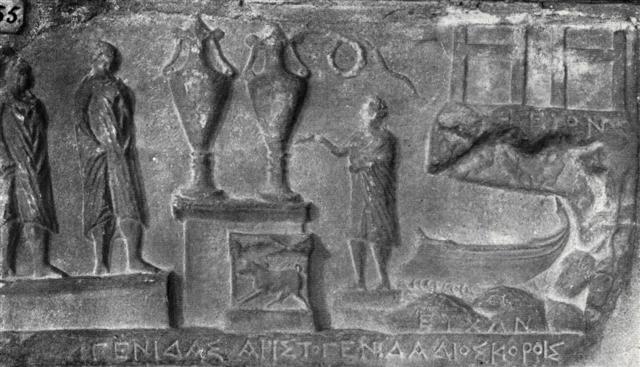|
1. One of the signs of the Gemini twins was the dokana: ... On votive reliefs they are depicted with a variety of symbols representing the concept of twinhood, such as the dokana (δόκανα - two upright piece of wood connected by two cross-beams), a pair of amphorae, a pair of shields, or a pair of snakes ... Wikipedia fails to give us us any more information about this sign. It was hardly like a pair of capital T letters side by side, instead it ought to have been a sign similar to the single capital of the pi letter in the Greek alphabet (Π), so I thought. But my idea of 2 cycles ('years') of equal length in the year is probably not a correct description - otherwise a modified π (with double cross-beams at the top) to indicate the 2nd cycle would have been a reasonable guess. Still, π is letter number 16 (= 32 / 2) in the Greek alphabet (of 24 letters). Thus it can be thought of as standing at the end of the first ⅔ of the letters. Looking outside Wikipedia I found an item worthy of notice, said to be 'a Lakonian grave relief':
... Their mother was Leda, but Castor was the mortal son of Tyndareus, king of Sparta, and Pollux the divine son of Zeus, who visited Leda in the guise of a swan ... The redmarked Laconia on the map below has 2 'legs', and its main city was Sparta, ruled by 2 kings of equal rank, a pair of 'twin kings':  The dokana was presumably a somewhat more elaborate sign than a capital π with a pair of 'crossbeams' at the top. Moreover, far down in my memory banks lies an idea of dokana as a modified capital eta (the 7th letter) with a pair of crossbeams, i.e. similar to Η. After a seach in my old papers I indeed found the picture I had faintly remembered:
At top right is a pair of structures, formed somewhat like H H and in the central position, standing on a podium, is a pair of 'urns'. To the left is the pair of twins, Castor and Pollux. This picture I once copied from The Cult of the Heavenly Twins by J. Rendel Harris, a book I had borrowed because I was intrigued by a reference in Hamlet's Mill: "In the Gospel of Mark III.17, the 'twins' James and John, the sons of Zebedee, are given by Jesus the name of Boanerges, which the Evangelist explains as meaning 'Sons of Thunder'. This was long overlooked but eventually became the title of a work by a distinguished scholar, too soon forgotten, Rendel Harris. Here the Thunder Twins were shown to exist in cultures as different as Greece, Scandinavia and Peru. They call to mind the roles of Magni and Modi, not actually called twins, but successors of Thor, in Ragnarok. But to quote from Harris: We have shown that it does not necessarily follow that when the parenthood of the Thunder is recognized, it necessarily extends to both of the twins. The Dioscuri may be called unitedly, Sons of Zeus; but a closer investigation shows conclusively that there was a tendency in the early Greek cults to regard one twin as of divine parentage, and the other of human. Thus Castor is credited to Tyndareus, Pollux to Zeus ... The extra child made the trouble, and was credited to an outside source. Only later will the difficulty of discrimination lead to the recognition of both as Sky-boys or Thunder-boys. An instance from a remote civilization will show that this is the right view to take. For example, Arriaga, in his 'Extirpation of Idolatry in Peru' tells us that 'when two children are produced at one birth, which they call Chuchos or Curi, and in el Cuzco Taqui Hua-hua, they hold it for an impious and abominable occurrence, and they say, that one of them is the child of the Lightning, and require a severe penance, as if they had committed a great sin'. And it is interesting to note that when the Peruvians, of whom Arriaga speaks, became Christians, they replaced the name of Son of Thunder, given to one of the twins, by the name of Santiago, having learnt from their Spanish (missionary) teachers that St. James (Santiago) and St. John had been called Sons of Thunder by our Lord, a phrase which these Peruvian Indians seem to have understood, where the great commentators of the Christian Church had missed the meaning ... Another curious and somewhat similar transfer of the language of the Marcan story in the folk-lore of a people, distant both in time and place ... will be found, even at the present day, amongst the Danes ... Besides the conventional flint axes and celts, which commonly pass as thunder-missiles all over the world, the Danes regard the fossil sea-urchin as a thunderstone, and give it a peculiar name. Such stones are named in Salling, sebedaei-stones, s'bedaei; in North Salling they are called sepadeie-stones. In Norbaek, in the district of Viborg, the peasantry called them Zebedee stones! At Jebjerg, in the parish of Cerum, district of Randers, they called them sebedei-stones ... The name that is given to these thunderstones is, therefore, very well established, and it seems certain that it is derived from the reference to the Sons of Zebedee in the Gospel as sons of Thunder. The Danish peasant, like the Peruvian savage, recognised at once what was meant by Boanerges, and called his thunderstone after its patron saint. This might have given pause to later hyperscholars like Bultmann, before they proceeded to 'de-mythologize' the Bible. One never knows what one treads underfoot." (Hamlet's Mill)
|


